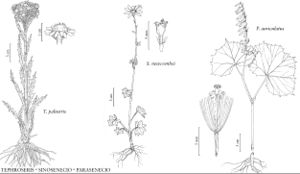Sinosenecio
Opera Bot. 44: 48, figs. 22F-K, 23. 1978.
| Taxon | Illustrator ⠉ | |
|---|---|---|
 | Tephroseris palustris Sinosenecio newcombei Parasenecio auriculatus | Yevonn Wilson-Ramsey Yevonn Wilson-Ramsey Yevonn Wilson-Ramsey |
Perennials, 10–30 cm (glabrous or sparsely tomentose; caudices sometimes rhizomatous, sometimes fibrous-rooted). Stems single or loosely clustered, erect. Leaves basal and cauline (sometimes mostly basal, distal usually smaller, bractlike); alternate; petiolate (petioles sometimes proximally dilated, ± sheathing stems, distally not winged); blades palmately or subpalmately nerved, ovate to subreniform [orbiculate to deltate], margins lobulate-dentate [dentate, denticulate, entire], faces glabrous or sparsely arachnose to tomentose. Heads radiate, borne singly [in corymbiform to paniculiform arrays]. Calyculi 0 (cauline bractlets sometimes approaching bases of heads). Involucres campanulate to hemispheric, [3–] 6–10+ mm diam. Phyllaries persistent, usually 8 or 13 in (1–) 2 series, erect (reflexed in fruit), distinct [basally connate], ± lanceolate, equal, margins ± scarious. Receptacles flat to convex, smooth [foveolate, sometimes setaceous], epaleate. Ray-florets 8–13, pistillate, fertile; corollas yellow to orange-yellow (sometimes drying pink). Disc-florets [20–] 30–60+, bisexual, fertile; corollas yellow to orange-yellow, tubes shorter than or equaling funnelform [campanulate] throats, lobes 5, erect or recurved, lance-deltate; style-branches: stigmatic areas continuous [in 2 lines], apices rounded-truncate. Cypselae ± columnar to prismatic, 5-ribbed or 10-ribbed or nerved, glabrous [puberulent]; pappi persistent (fragile [readily falling]), of 40–60, white, barbellulate to smooth bristles [absent on ray cypselae]. x = 24.
Distribution
B.C., mostly e Asia, chiefly China and Korea
Discussion
Species ca. 30 (1 in the flora).
Selected References
None.